Lingo

tonellidesign > Side table
Designed by the designer and architect Roberto Garbugli, the Lingo vase is designed as a furnishing accessory for interiors. The wooden supporting structure is covered externally by four panels in mirror, smoked and bronze mirror, surrounded by a polished stainless steel edge.
Table Unity
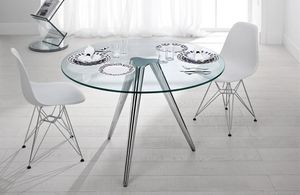
tonellidesign > Table
The glass table Unity was designed by architect Karim Rashid. Dining table, solid and elegant, Unity is able to adapt to any environment. It is made of a round tempered glass top available in transparent, smoked or extra clear and a metal base in chrome or white lacquered.
Gatwick

molteni > Table
This table designed by Milanese architect Rodolfo Dordoni takes the name of Londons Gatwick airport one of the busiest in the world. A hub where cosmopolitan travellers meet every hour of the day and night on their way in or out of the U.K. capital much like a table where people meet for dinner.
marmoleum meets mendini Plato Sotto

forbo > Synthetic Floor
In close cooperation with the Italian architect and designer Alessandro Mendini we have created 3 unique Marmoleum designs that reflect his pointillist style: Proust, Harlekino and Plato. The 3 designs are available in a bright, contrasting variant and one of more subdued, greyish tones, both in the same geometric pattern.
marmoleum meets mendini Proust Sotto

forbo > Synthetic Floor
In close cooperation with the Italian architect and designer Alessandro Mendini we have created 3 unique Marmoleum designs that reflect his pointillist style: Proust, Harlekino and Plato. The 3 designs are available in a bright, contrasting variant and one of more subdued, greyish tones, both in the same geometric pattern.
FH38 Windsor Chair

carlhansen > Chair
The Windsor Chair was designed in 1938 by the Danish architect and cabinetmaker Frits Henningsen. In continuous production at Carl Hansen & Søn until 2003, the majestic chair is now reissued with modern comfort in mind.
Castore dining table Angelo Mangiarotti, 1975

karakterCopenhagen > Table
Castore is a glass and marble table by Italian architect, sculptor and designer Angelo Mangiarotti. Designed in 1975 for Sorgente dei Mobili, the distinct design is now presented by Karakter, available as a 130cm dining table. The round glass top rests on a heavy marble pillar, and visually, Mangiarotti would have it seem that only a small marble bowl on top of the glass plate is holding it in place. The rounded corners on both the pillar and the bowl ads a sense of softness to the otherwise heavy aesthetics of the marble. The marble bowl can be removed and used as an individual element. However, keeping it as an integral part of the design, you can enjoy additional rounded corners, as the bowl reflects in the glass table top.
BK11 Lounge Chair

carlhansen > Chair
The BK11 lounge chair was designed in 1959 by Danish architect Bodil Kjær as part of her architecturally inspired Indoor-Outdoor Series. With a linear form influenced by Cubism, the chair’s solid teak construction is designed to patinate beautifully with age and use. The result of expert craftsmanship, the chair’s design has an inclined seat and back, with armrests, legs and runners that are mortised together to form two squares. It can be supplied with slender, supportive cushions made from weather-resistant Sunbrella fabric for additional comfort. Cushion is sold separately.
Linha "Dining"

minotti > Table
An expression of the minimalism that pervades the Brazilian architect’s designs, the Linha dining table is a manifesto of his constant pursuit of elegance in the proportions of his creations, and of his almost obsessive attention to detail. Linha, or “line” in Portuguese, is his response to the challenge of designing a dining table with a large span, a structure only 16 mm thick and a top that can reach up to 4 metres in length. Visually, it appears extremely lightweight and airy, despite the strong impact of the materials used, in which marble boldly takes centre stage. In the more sculptural version, the structure designs a bridge, with the top being flush with the sides, whereas in the other tables the blade-like legs, with the section curved on the inside, are set back from the top. The stratified bearing structure with matt black lacquered finish features aluminium sides with Golden Brown finish and a top in Grigio Orobico marble. The top in flamed Tobacco oak and palisander Santos with matt polyester varnished finish is also available – woods that, with their material textures, give great character to the product. The Linha family also includes a round table available in four sizes.
Low table Farniente
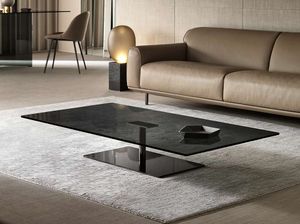
tonellidesign > Coffee table
The low glass table Farniente was created by architect and designer Giovanni Tommaso Garattoni. Flashes of light and three-dimensional effects, thanks to the mirror chromed base and support that make this cocktail table very special and refined. Equipped with tempered glass top in transparent, extra clear or smoked, the low table Farniente can be perfectly combined with luxurious settings and is embellished by the base available in three versions: base and top round, rectangular, square.
Saffo Angelo Mangiarotti, 1967

karakterCopenhagen > Table lamp
The spectacular Saffo Lamp was designed in 1966 by Italian architect, sculptor, and designer Angelo Mangiarotti and has since been a coveted vintage object. The remarkable design bares testament to his background as a sculptor and shows his unique approach to combining shapes and materials. Saffo is made of blown glass and spreads a soft light that enhances the many material characteristics of the glass. The white glass in the bottom elegantly hides the light source and as the shape of the mushroom starts to form, the white glass blends into transparent and makes way for the light. The sculptural qualities of the Saffo Lamp make it a spectacular design object whether turned on or off.
AQ01™

fritzhansen > Table lamp
The AQ01™ offers a fresh take on the classic architect’s desk light. Distinguished by its delicate lines and matt finish, the light offers a refined elegance and genius utility. Technology allows springs to be hidden within the design and AQ01’s shade to be switched on and off, or dimmed up and down, with the touch of a hand on the lamp’s shade. The table lamp is a minimal task light with great adjustability.
BK16 Side Table

carlhansen > Side table
The BK16 side table was designed in 1959 by Danish architect and professor Bodil Kjær. Part of a collection of beautifully crafted indoor-outdoor furniture in solid teak, its Cubist-inspired form echoes other designs in the series, all of which have a clean-lined and geometric quality. Perfectly proportioned to match the height of the collection’s lounge chair, the BK16 side table displays the same superior craftsmanship and striking simplicity that underpins the entire Indoor-Outdoor Series.
AQ01™

fritzhansen > Wall lamp
The AQ01™ offers a fresh take on the classic architect’s desk light. Distinguished by its delicate lines and matt finish, the light offers a refined elegance and genius utility. Technology allows springs to be hidden within the design and AQ01’s shade to be switched on and off, or dimmed up and down, with the touch of a hand on the lamp’s shade. The wall solution is a minimal task light with great adjustability.
AQ01™
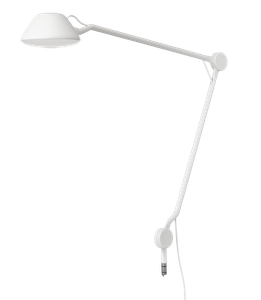
fritzhansen > Table lamp
The AQ01™ offers a fresh take on the classic architect’s desk light. Distinguished by its delicate lines and matt finish, the light offers a refined elegance and genius utility. Technology allows springs to be hidden within the design and AQ01’s shade to be switched on and off, or dimmed up and down, with the touch of a hand on the lamp’s shade. The plug-in lamp is a minimal task light with great adjustability.
Paulistano - leather

objekto > Chair
A cult leather armchair signed by the hand of architect Paulo Mendes da Rocha. Very comfortable, the Paulistano is a design classic with a timeless elegance.The spring steel frame, presented in its original phosphated carbon steel finish, polished stainless steel, or covered with an extremely durable epoxy paint, is covered with a sensual and deep piece of full grain vegetable leather. Placed in a living room, in a bedroom, this armchair with its minimalist lines will fit into any interior and will take on an extraordinary patina over time. Designed in 1957 by Paulo Mendes da Rocha, the Paulistano armchair was part, for many years, of the living rooms of the Athletic Club of São Paulo. The constructivist concept of the structure, made up from a single bended steel bar, and its cover, made up of leather or cotton, procure to this armchair an esthetical lightness and an incomparable comfort. Edited in small series within the last years, the Paulistano armchair emerges from the past to show that the purity and the elegance of its lines are timeless: a masterpiece. The Paulistano lounge chair has been included in the famous permanent collection of the Museum of Modern Art of New York (MoMA)
BK12 Lounge Sofa

carlhansen > Bench
In 1959, Danish architect Bodil Kjær launched her Indoor-Outdoor Series, which included the supremely comfortable BK12 lounge sofa. Crafted from solid teak with a slatted seat and back, the sofa displays the same geometric sensibility that underpins the rest the collection. This quality is further enhanced by the armrests, legs and runners, which are morticed together to form sleek squares. Conceived as an architectural element, with proportions designed accordingly, the BK12 lounge sofa is suitable for indoor and outdoor use. Cushion is sold separately.
Utzon Stool

fritzhansen > Stool
The Utzon Stool is a captivating creative expression by acclaimed Danish architect Jørn Utzon. It was designed during the same period as the Sydney Opera House. The stool is a meticulously crafted functional sculpture. Decorative in appearance yet deceptively comfortable. Crafted with oiled solid beech wood, veneer beech wood, and adorned with beautiful brass detailing. The stool exudes an extrovert playfulness in its fascinating appearance.
TA001P Dream Chair

carlhansen > Armchair
The TA001P Dream Chair is the creation of Japanese architect Tadao Ando. Ando admired the sculptural minimalism inherent in all Hans J. Wegner’s work and strove to match it in his own designs. The upholstered back and seat add comfort and variety.
Linha Studio

minotti > Table
The evolution of the dining table designed by the Brazilian architect in 2020, the Linha Studio desk is available in five sizes, from the suite or home office desk to larger sizes for the office. The sculptural frame draws a large bridged area with the top lying flush to the sides, and two drawers underneath, positioned on the left. Linha, which means line in Portuguese, responds to the challenge of designing a desk with a slender frame, a top only 16 mm thick and from 180 to 250 cm long. Visually speaking, it is extremely light and airy, the ultimate expression of the minimalism that pervades the designs of Marcio Kogan / studio mk27, which have always focused on finding proportions that convey a certain elegance. The entire frame is characterised by sides with a Golden Brown finish, while the top and front of the drawers are in Dark Brown stained palisander Santos, with a matt polyester lacquered finish, wood with an interesting texture that adds volumes of personality to the design. A cable hole compartment is located on the table top, which can house a storage tray in Golden Brown varnished metal, with internal partitions and a background in Dark Brown saddle-hide positioned near the drawers.
Casper

molteni > drawer
A rigorous and minimalist design by the Belgian architect destined for the bedroom. Bedside table with one drawer and a two- or four-drawer chest of drawers the frames are painted pewter or copper to be teamed with tops and drawers featuring eucalyptus and graphite oak.
Cleo Small Tables

molteni > Coffee table
Cleo is a small domestic sculpture that derives from the professional experience of architect and creative director Vincent Van Duysen.
Furniture element Opalina toeletta

tonellidesign > Side table
The furniture element Opalina toeletta, created by architect Cristina Celestino, is made of a structure in extra clear, extra clear frosted or smoked glass, a frontal round mirror and a top also available in version extra clear, extra clear frosted or smoked glass. While the drawer underneath, in matt white wood, can be covered in beige leather. Conceived as dressing table for the sleeping area, the furniture unit donates a pleasant sense of harmony, given by the brightness that transpires from its rounded shape.
Crate Low Table

hay > Side table
Initially designed to make use of surplus wooden shipping crates by Dutch architect and designer Gerrit Rietveld in 1934 the Crate Collection has been relaunched in a Rietveld Originals x HAY collaboration. Made with respect for the original design the Crate Low Table shares the same precisely balanced proportions and transparent construction to minimise production costs and optimise the assembly process. Featuring low proportions with a square tabletop and diagonal crossbars the tables simplicity and spatial design mirrors the designers architectural style providing functionality and comfort without absorbing space. Crafted in solid pine with a water-based lacquered finish in different colour options the Crate Low Table is suitable for a wealth of outdoor settings.
Daiki "Outdoor"

minotti > Outdoor furniture
The Daiki seats, born out of the Brazilian architect’s passion for Japanese culture, go outdoors, where the open-air space is conceived and experienced as an extension of the indoor living area: a veritable tribute to Japanese design culture. The Daiki family includes armchairs with a deep seat, available both with and without arms, a dining little armchair and a footstool. Created using sophisticated wood crafting techniques, the curved shell in solid teak comprises two elements joined at a 45° angle, with a sloping backrest that guarantees maximum comfort. In the outdoor version the shell offers a snug fit for the stitched cushions, and is set on a stainless-steel frame with Bronze-coloured varnished polished legs. A design that also explores and reinterprets the American Mid-Century atmospheres, injecting new life into the style of contemporary outdoor furnishing with its clean, bold lines, exquisite teak working technique and balanced proportions.
pp571
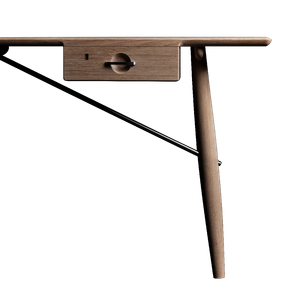
pp-mobel > Desk
Hans J. Wegner designed the exquisite pp571 Architect’s Desk in 1953 as a match to the Round Chair. Later in 1955 he designed the Swivel Chair, completing a line of exclusive masterpieces for the CEO’s office. The desk marks the beginning of Wegner’s work on combining sharp steel and sculptural solid wood in elegant and well-balanced solutions.
Crate Lounge Chair

hay > Chair
Initially designed to make use of surplus wooden shipping crates by Dutch architect and designer Gerrit Rietveld in 1934 the Crate Collection has been relaunched in a Rietveld Originals x HAY collaboration. Made with respect for the original design the Crate Lounge Chair shares the same precisely balanced proportions and transparent construction to minimise production costs and optimise the assembly process. Featuring low proportions with a gently sloping back and seat with supportive armrests the chairs simplicity and spatial design mirrors the designers architectural style providing functionality and comfort without absorbing space. Crafted in solid pine with a water-based lacquered finish in different colour options the Crate Lounge Chair is suitable for a wealth of outdoor settings and can be supplemented with optional seat cushions in selected textiles for extra comfort.
Crate Side Table

hay > Side table
Initially designed to make use of surplus wooden shipping crates by Dutch architect and designer Gerrit Rietveld in 1934 the Crate Collection has been relaunched in a Rietveld Originals x HAY collaboration. Made with respect for the original design the Crate Side Table shares the same precisely balanced proportions and transparent construction to minimise production costs and optimise the assembly process. Featuring a square tabletop and extra storage shelf the tables simplicity and spatial design mirrors the designers architectural style providing functionality and comfort without absorbing space. Crafted in solid pine with a water-based lacquered finish in different colour options the Crate Side Table is suitable for a wealth of outdoor settings.
Bellevue AJ9

andtradition > Wall lamp
With the Bellevue Lamp, Danish architect and designer Arne Jacobsen embodies the minimalism of the Modernist Movement with the functionalism of Bauhaus. Viewed as the driving force behind Danish Modernism, Jacobsen’s preference for graceful lines and simple, organic forms are readily recognisable in the Bellevue lamp. The re-launch of this iconic lamp involves a return to the original Bellevue shape in four styles: the floor, wall, plug-in, and table lamp.
Bookcase Hemingway
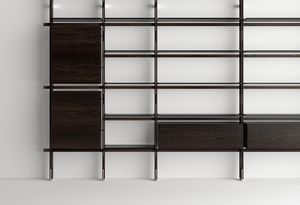
tonellidesign > Cabinet
The bookcase Hemingway with its refined and strong shapes was created by architect Massimo Castagna. It is a bookcase with frame in solid wood, made of uprights and beams, wall or ceiling fixing. The uprights are made lighter by frontal and lateral fissures and are characterised by inserts in polished metal. The horizontal beams physically and visually define the shape and rhythm of this bookcase. The structure supports the shelves and storage units available in different functions and dimensions. The bookcase Hemingway can accommodate horizontal storage units with flap opening and vertical units with hinge door, made of glass and wood. It also has a wooden desk top. The glass shelves and their peculiar side slots, are fixed to the uprights through interlocking pins, each shelf is provided with fall arrest security system. Vertical uprights and horizontal beams in solid wood complete the structure and are available in Siberian Ash or Eucalipto, with inserts and supports in polished chrome or gold. The shelves are in extra clear or smoked glass and the feet are height adjustable. Standard heights are 260 and 300cm, also available in custom size, and Tonelli Design proposes shelves in standard size 60 and 100cm. Storage units with flap opening and hinge door with structure in smoked glass and wooden door. Wooden desk top in 100cm, can be fitted out with cable entry. TV module with open storage unit in wood, size 160cm, to accommodate TVs up to 65 inches.
Bellevue AJ7
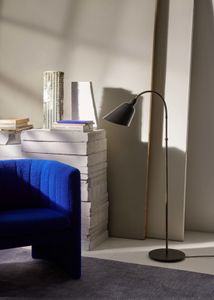
andtradition > Floor lamp
With the Bellevue Lamp, Danish architect and designer Arne Jacobsen embodies the minimalism of the Modernist Movement with the functionalism of Bauhaus. Viewed as the driving force behind Danish Modernism, Jacobsen’s preference for graceful lines and simple, organic forms are readily recognisable in the Bellevue lamp. The re-launch of this iconic lamp involves a return to the original Bellevue shape in four styles: the floor, wall, plug-in, and table lamp.
Daiki "Outdoor"
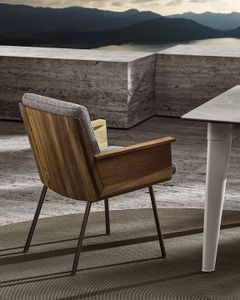
minotti > Outdoor furniture
The Daiki seats, born out of the Brazilian architect’s passion for Japanese culture, go outdoors, where the open-air space is conceived and experienced as an extension of the indoor living area: a veritable tribute to Japanese design culture. The Daiki family includes armchairs with a deep seat, available both with and without arms, a dining little armchair and a footstool. Created using sophisticated wood crafting techniques, the curved shell in solid teak comprises two elements joined at a 45° angle, with a sloping backrest that guarantees maximum comfort. In the outdoor version the shell offers a snug fit for the stitched cushions, and is set on a stainless-steel frame with Bronze-coloured varnished polished legs. A design that also explores and reinterprets the American Mid-Century atmospheres, injecting new life into the style of contemporary outdoor furnishing with its clean, bold lines, exquisite teak working technique and balanced proportions.
Crate Dining Chair

hay > Chair
Initially designed to make use of surplus wooden shipping crates by Dutch architect and designer Gerrit Rietveld in 1934 the Crate Collection has been relaunched in a Rietveld Originals x HAY collaboration. Made with respect for the original design the Crate Dining Chair shares the same precisely balanced proportions and transparent construction to minimise production costs and optimise the assembly process. Featuring a gently sloping back and supportive armrests the chairs simplicity and spatial design mirrors the designers architectural style providing functionality and comfort without absorbing space. Crafted in solid pine with a water-based lacquered finish in different colour options the Crate Dining Chair is suitable for a wealth of outdoor settings and can be supplemented with optional seat cushions in selected textiles for extra comfort.
Bellevue AJ11

andtradition > Table lamp
With the Bellevue Lamp, Danish architect and designer Arne Jacobsen embodies the minimalism of the Modernist Movement with the functionalism of Bauhaus. Viewed as the driving force behind Danish Modernism, Jacobsen’s preference for graceful lines and simple, organic forms are readily recognisable in the Bellevue lamp. The re-launch of this iconic lamp involves a return to the original Bellevue shape in four styles: the floor, wall, plug-in, and table lamp.
BRUCO MEDIUM

fontanaarte > Wall lamp
Designed for FontanaArte in 2003 by the designer, architect and urban planner Vico Magistretti, this small wall lamp is made up of two blown glass spheres. In shape and size, it is perfect in any space and domestic context.
Naked armchair

tonellidesign > Armchair
The Naked armchair, conceived by architect and designer Giovanni Tommaso Garattoni, has a minimal and clean structure. Composed of tempered glass, transparent or extra clear, it can be customized with the seat in matt leather, in the color variants of white or black. Thanks to its defined lines, the Naked armchair is the design piece suitable for personalizing studios and living rooms.
D.150.5 - Outdoor Collection
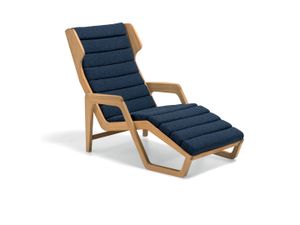
molteni > Outdoor furniture
In collaboration with the Gio Ponti Archives and the heirs of the renowned Milanese architect Molteni&C is reconstructing one of the rare pieces of furniture Gio Ponti designed for outdoor use the D.150.5 chaise longue projects for the cruise ship Andrea Doria in 1952.
Vitruvius Lilac Waterjet Mosaic

artistictile > Floor tile-stone
With echos of Leonardo DaVinci’s famous “Vitruvian Man”, the Vitruvius pattern models the ancient Roman architect Vitruvius’ description of perfect proportions in architecture and the human body. Vitruvius, part of our SPQR collection of stone mosaics, follows the golden rules of Vitruvian architecture: firmatis (durability), utilitas (utility) and venustatis (beauty). Its circular pattern reads as one circle overlapping another, which overlaps another, and so forth, similar to DaVinci’s drawing of the multi-limbed man. The result is an intricate, fluid, and visually stimulating pattern with origins in classic Roman aesthetics, updated for a modern palette. Stocked in three sophisticated colorways, Each crafted with carefully selected natural stones.
SETAREH METAL MEDIUM

fontanaarte > Ceiling lamp
This is the name of the family of lighting fixtures that Francesco Librizzi, a young Sicilian architect working in Milan, has designed for the first time for FontanaArte. Setareh was born of the idea of giving form to light. The lamp is composed of a sphere magically suspended within a thin metal structure. The play of circular masses and trajectories generates a balanced design of gravitational dynamics. The light from the sphere is diffused into the surrounding space, illuminating the frame. The reflections of the metal render the luminous field visible, space influenced by light, by its aura. The result is a collection of lighting elements, available in tabletop and suspension versions, of extraordinary poetic grace. Setareh takes on new dimensions: elongated, with either two or three spherical elements that work separately or together. Its vocation is the illumination of large spaces, with double-height ceilings or otherwise ample enough to accomodate expansive compositions of multiple elements. A firmament of Setareh, ‘star’ in the ancient Farsi language.
SETAREH METAL LARGE

fontanaarte > Ceiling lamp
This is the name of the family of lighting fixtures that Francesco Librizzi, a young Sicilian architect working in Milan, has designed for the first time for FontanaArte. Setareh was born of the idea of giving form to light. The lamp is composed of a sphere magically suspended within a thin metal structure. The play of circular masses and trajectories generates a balanced design of gravitational dynamics. The light from the sphere is diffused into the surrounding space, illuminating the frame. The reflections of the metal render the luminous field visible, space influenced by light, by its aura. The result is a collection of lighting elements, available in tabletop and suspension versions, of extraordinary poetic grace. Setareh takes on new dimensions: elongated, with either two or three spherical elements that work separately or together. Its vocation is the illumination of large spaces, with double-height ceilings or otherwise ample enough to accomodate expansive compositions of multiple elements. A firmament of Setareh, ‘star’ in the ancient Farsi language.
SETAREH LARGE
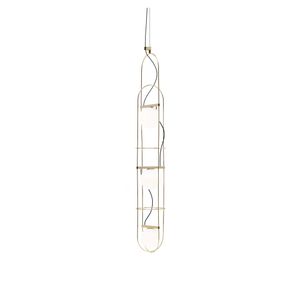
fontanaarte > Ceiling lamp
This is the name of the family of lighting fixtures that Francesco Librizzi, a young Sicilian architect working in Milan, has designed for the first time for FontanaArte. Setareh was born of the idea of giving form to light. The lamp is composed of a sphere magically suspended within a thin metal structure. The play of circular masses and trajectories generates a balanced design of gravitational dynamics. The light from the sphere is diffused into the surrounding space, illuminating the frame. The reflections of the metal render the luminous field visible, space influenced by light, by its aura. The result is a collection of lighting elements, available in tabletop and suspension versions, of extraordinary poetic grace. Setareh takes on new dimensions: elongated, with either two or three spherical elements that work separately or together. Its vocation is the illumination of large spaces, with double-height ceilings or otherwise ample enough to accomodate expansive compositions of multiple elements. A firmament of Setareh, ‘star’ in the ancient Farsi language.
SETAREH MEDIUM

fontanaarte > Table lamp
This is the name of the family of lighting fixtures that Francesco Librizzi, a young Sicilian architect working in Milan, has designed for the first time for FontanaArte. Setareh was born of the idea of giving form to light. The lamp is composed of a sphere magically suspended within a thin metal structure. The play of circular masses and trajectories generates a balanced design of gravitational dynamics. The light from the sphere is diffused into the surrounding space, illuminating the frame. The reflections of the metal render the luminous field visible, space influenced by light, by its aura. The result is a collection of lighting elements, available in tabletop and suspension versions, of extraordinary poetic grace. Setareh takes on new dimensions: elongated, with either two or three spherical elements that work separately or together. Its vocation is the illumination of large spaces, with double-height ceilings or otherwise ample enough to accomodate expansive compositions of multiple elements. A firmament of Setareh, ‘star’ in the ancient Farsi language.
Vitruvius Botanic Green Waterjet Mosaic

artistictile > Floor tile-stone
With echos of Leonardo DaVinci’s famous “Vitruvian Man”, the Vitruvius pattern models the ancient Roman architect Vitruvius’ description of perfect proportions in architecture and the human body. Vitruvius, part of our SPQR collection of stone mosaics, follows the golden rules of Vitruvian architecture: firmatis (durability), utilitas (utility) and venustatis (beauty). Its circular pattern reads as one circle overlapping another, which overlaps another, and so forth, similar to DaVinci’s drawing of the multi-limbed man. The result is an intricate, fluid, and visually stimulating pattern with origins in classic Roman aesthetics, updated for a modern palette. Stocked in three sophisticated colorways, Each crafted with carefully selected natural stones.
SETAREH GLASS MEDIUM

fontanaarte > Table lamp
This is the name of the family of lighting fixtures that Francesco Librizzi, a young Sicilian architect working in Milan, has designed for the first time for FontanaArte. Setareh was born of the idea of giving form to light. The lamp is composed of a sphere magically suspended within a thin metal structure. The play of circular masses and trajectories generates a balanced design of gravitational dynamics. The light from the sphere is diffused into the surrounding space, illuminating the frame. The reflections of the metal render the luminous field visible, space influenced by light, by its aura. The result is a collection of lighting elements, available in tabletop and suspension versions, of extraordinary poetic grace. Setareh takes on new dimensions: elongated, with either two or three spherical elements that work separately or together. Its vocation is the illumination of large spaces, with double-height ceilings or otherwise ample enough to accomodate expansive compositions of multiple elements. A firmament of Setareh, ‘star’ in the ancient Farsi language.
SETAREH SMALL

fontanaarte > Ceiling lamp
This is the name of the family of lighting fixtures that Francesco Librizzi, a young Sicilian architect working in Milan, has designed for the first time for FontanaArte. Setareh was born of the idea of giving form to light. The lamp is composed of a sphere magically suspended within a thin metal structure. The play of circular masses and trajectories generates a balanced design of gravitational dynamics. The light from the sphere is diffused into the surrounding space, illuminating the frame. The reflections of the metal render the luminous field visible, space influenced by light, by its aura. The result is a collection of lighting elements, available in tabletop and suspension versions, of extraordinary poetic grace. Setareh takes on new dimensions: elongated, with either two or three spherical elements that work separately or together. Its vocation is the illumination of large spaces, with double-height ceilings or otherwise ample enough to accomodate expansive compositions of multiple elements. A firmament of Setareh, ‘star’ in the ancient Farsi language.
SETAREH GLASS MEDIUM

fontanaarte > Table lamp
This is the name of the family of lighting fixtures that Francesco Librizzi, a young Sicilian architect working in Milan, has designed for the first time for FontanaArte. Setareh was born of the idea of giving form to light. The lamp is composed of a sphere magically suspended within a thin metal structure. The play of circular masses and trajectories generates a balanced design of gravitational dynamics. The light from the sphere is diffused into the surrounding space, illuminating the frame. The reflections of the metal render the luminous field visible, space influenced by light, by its aura. The result is a collection of lighting elements, available in tabletop and suspension versions, of extraordinary poetic grace. Setareh takes on new dimensions: elongated, with either two or three spherical elements that work separately or together. Its vocation is the illumination of large spaces, with double-height ceilings or otherwise ample enough to accomodate expansive compositions of multiple elements. A firmament of Setareh, ‘star’ in the ancient Farsi language.
MS Series

fritzhansen > Floor lamp
The MS Series is a clean, cool and modern lighting collection created by contemporary Danish architect and designer Mette Schelde. A modern and minimal reinvention of classic lamp designs, the MS Series balances minimalist transparency with soft curves as the lamps’ clean lines meet Schelde’s signature circle shape found throughout much of her work. All lamps in the series feature an integrated dial for turning on and dimming control. Modern, minimal and mood-enhancing, the purist expression of the MS011 floor lamp is offset with warm, ambient lighting that can be adjusted in height, direction and intensity to illuminate a space.
Trolley Dappertutto

tonellidesign > Cabinet
The trolley Dappertutto is born from a project by Marco Gaudenzi, renowned architect of Pesaro. Overall it is a real designer furniture, ideal as furnishing complement for the bathroom, entrance or similar areas. Completely in transparent glass, the trolley Dappertutto is available in different heights and number of shelves, resulting spacious and handy, also because of the castors fixed to the base.
Ribbon

cappellini > Stool
Continuously flowing ribbons of laser-cut metal compose the Ribbon stool by Nendo, the team of designers headed by architect Oki Sato.
Aida Angelo Mangiarotti, 1988
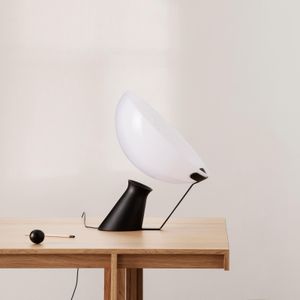
karakterCopenhagen > Table lamp
Esteemed for his researched and controlled approach to materials, Italian architect, sculptor and designer Angelo Mangiarotti created the almost gravity-defying Aida lamp with its visual disconnect between the base and shade and a pleasing ambient light. Referencing principles of his hailed architecture, where slim, elegant pillars support large and heavy ceilings in an almost impossible lift, Mangiarotti conceived Aida’s beautifully poised silhouette.